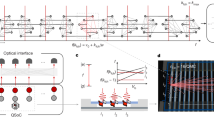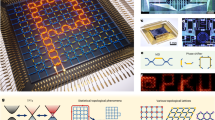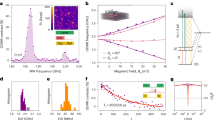Abstract
Improvements in temporal resolution of single-photon detectors enable increased data rates and transmission distances for both classical and quantum optical communication systems, higher spatial resolution in laser ranging, and observation of shorter-lived fluorophores in biomedical imaging. In recent years, superconducting nanowire single-photon detectors (SNSPDs) have emerged as the most efficient time-resolving single-photon-counting detectors available in the near-infrared, but understanding of the fundamental limits of timing resolution in these devices has been limited due to a lack of investigations into the timescales involved in the detection process. We introduce an experimental technique to probe the detection latency in SNSPDs and show that the key to achieving low timing jitter is the use of materials with low latency. By using a specialized niobium nitride SNSPD we demonstrate that the system temporal resolution can be as good as 2.6 ± 0.2 ps for visible wavelengths and 4.3 ± 0.2 ps at 1,550 nm.
This is a preview of subscription content, access via your institution
Access options
Access Nature and 54 other Nature Portfolio journals
Get Nature+, our best-value online-access subscription
$29.99 / 30 days
cancel any time
Subscribe to this journal
Receive 12 print issues and online access
$209.00 per year
only $17.42 per issue
Buy this article
- Purchase on Springer Link
- Instant access to full article PDF
Prices may be subject to local taxes which are calculated during checkout





Similar content being viewed by others
Data availability
The data that support the plots within this paper and other findings of this study are available from the corresponding author upon reasonable request.
References
Gol’tsman, G. N. et al. Picosecond superconducting single-photon optical detector. Appl. Phys. Lett. 79, 705–707 (2001).
Marsili, F. et al. Detecting single infrared photons with 93% system efficiency. Nat. Photon. 7, 210–214 (2013).
Reddy, D. V. et al. Exceeding 95% system efficiency within the telecom C-band in superconducting nanowire single photon detectors. In Conference on Lasers and Electro-Optics FF1A.3 (OSA, 2019).
Vetter, A. et al. Cavity-enhanced and ultrafast superconducting single-photon detectors. Nano Lett. 16, 7085–7092 (2016).
Wollman, E. E. et al. A kilopixel array of superconducting nanowire single-photon detectors. Opt. Express 27, 35279–35289 (2019).
Slichter, D. H. et al. UV-sensitive superconducting nanowire single photon detectors for integration in an ion trap. Opt. Express 25, 8705–8720 (2016).
Wollman, E. E. et al. UV superconducting nanowire single-photon detectors with high efficiency, low noise, and 4 K operating temperature. Opt. Express 25, 26792–26801 (2017).
Chen, L. et al. Mid-infrared laser-Induced fluorescence with nanosecond time resolution using a superconducting nanowire single-photon detector: new technology for molecular science. Acc. Chem. Res. 50, 1400–1409 (2017).
Shalm, L. K. et al. Strong loophole-free test of local realism. Phys. Rev. Lett. 115, 250402 (2015).
Takesue, H. et al. Quantum key distribution over a 40-dB channel loss using superconducting single-photon detectors. Nat. Photon. 1, 343–348 (2007).
Yin, H. L. et al. Measurement-device-independent quantum key distribution over a 404 km optical fiber. Phys. Rev. Lett. 117, 190501 (2016).
Boaron, A. et al. Secure quantum key distribution over 421 km of optical fiber. Phys. Rev. Lett. 121, 190502 (2018).
Bussières, F. et al. Quantum teleportation from a telecom-wavelength photon to a solid-state quantum memory. Nat. Photon. 8, 775–778 (2014).
Takesue, H. et al. Quantum teleportation over 100 km of fiber using MoSi superconducting nanowire single-photon detectors. Optica 2, 832–835 (2015).
Valivarthi, R. et al. Quantum teleportation across a metropolitan fibre network. Nat. Photon. 10, 676–680 (2016).
McCarthy, A. et al. Kilometre-range, high resolution depth imaging using 1560 nm wavelength single-photon detection. Opt. Express 21, 8904–8915 (2013).
Grein, M. E. et al. Design of a ground-based optical receiver for the lunar laser communications demonstration. In Int. Conf. Space Optical Systems and Applications 78–82 (IEEE, 2011).
Hadfield, R. H. Single-photon detectors for optical quantum information applications. Nat. Photon. 3, 696–705 (2009).
Becker, W. Advanced Time-Correlated Single Photon Counting Techniques (Springer, 2005).
Wu, J. et al. Improving the timing jitter of a superconducting nanowire single-photon detection system. Appl. Opt. 56, 2195–2200 (2017).
Sidorova, M. et al. Physical mechanisms of timing jitter in photon detection by current-carrying superconducting nanowires. Phys. Rev. B 96, 184504 (2017).
Caloz, M. et al. High-detection efficiency and low-timing jitter with amorphous superconducting nanowire single-photon detectors. Appl. Phys. Lett. 112, 061103 (2018).
Sidorova, M. et al. Timing jitter in photon detection by straight superconducting nanowires: effect of magnetic field and photon flux. Phys. Rev. B 98, 134504 (2018).
Zhao, Q.-Y. et al. Single-photon imager based on a superconducting nanowire delay line. Nat. Photon. 11, 247–251 (2017).
Calandri, N., Zhao, Q. Y., Zhu, D., Dane, A. & Berggren, K. K. Superconducting nanowire detector jitter limited by detector geometry. Appl. Phys. Lett. 109, 152601 (2016).
Zhu, D. et al. Superconducting nanowire single-photon detector with integrated impedance-matching taper. Appl. Phys. Lett. 114, 042601 (2019).
Smirnov, K. V. et al. Rise time of voltage pulses in NbN superconducting single photon detectors. Appl. Phys. Lett. 109, 052601 (2016).
Vodolazov, D. Yu. Single-photon detection by a dirty current-carrying superconducting strip based on the kinetic-equation approach. Phys. Rev. Appl. 7, 034014 (2017).
Vodolazov, D. Yu. Minimal timing jitter in superconducting nanowire single-photon detectors. Phys. Rev. Appl. 11, 014016 (2019).
Allmaras, J. P., Kozorezov, A. G., Korzh, B. A., Berggren, K. K. & Shaw, M. D. Intrinsic timing jitter and latency in superconducting nanowire single-photon detectors. Phys. Rev. Appl. 11, 034062 (2019).
Zhang, J. et al. Time delay of resistive-state formation in superconducting stripes excited by single optical photons. Phys. Rev. B 67, 132508 (2003).
Cahall, C. et al. Multi-photon detection using a conventional superconducting nanowire single-photon detector. Optica 4, 1534–1535 (2017).
Kozorezov, A. G. et al. Fano fluctuations in superconducting-nanowire single-photon detectors. Phys. Rev. B 96, 054507 (2017).
Dane, A. E. et al. Bias sputtered NbN and superconducting nanowire devices. Appl. Phys. Lett. 111, 122601 (2017).
Caloz, M. et al. Intrinsically-limited timing jitter in molybdenum silicide superconducting nanowire single-photon detectors. J. Appl. Phys. 126, 164501 (2019).
Wu, H., Gu, C., Cheng, Y. & Hu, X. Vortex-crossing-induced timing jitter of superconducting nanowire single-photon detectors. Appl. Phys. Lett. 111, 062603 (2017).
Nolet, F. et al. Quenching circuit and SPAD integrated in CMOS 65 nm with 7.8 ps FWHM single photon timing resolution. Instruments 2, 19 (2018).
Amri, E., Boso, G., Korzh, B. & Zbinden, H. Temporal jitter in free-running InGaAs/InP single-photon avalanche detectors. Opt. Lett. 41, 5728–5731 (2016).
Wang, X. et al. Oscilloscopic capture of greater-than-100 GHz, ultra-low power optical waveforms enabled by integrated electro-optic devices. J. Light. Technol. 38, 166–173 (2020).
Ferrari, S., Schuck, C. & Pernice, W. Waveguide-integrated superconducting nanowire single-photon detectors. Nanophotonics 7, 1725–1758 (2018).
Pernice, W. H. P. et al. High-speed and high-efficiency travelling wave single-photon detectors embedded in nanophotonic circuits. Nat. Commun. 3, 1325 (2012).
Akhlaghi, M. K., Atikian, H., Eftekharian, A., Loncar, M. & Hamed Majedi, A. Reduced dark counts in optimized geometries for superconducting nanowire single photon detectors. Opt. Express 20, 23610–23616 (2012).
Ho Eom, B., Day, P. K., LeDuc, H. G. & Zmuidzinas, J. A wideband, low-noise superconducting amplifier with high dynamic range. Nat. Phys. 8, 623–627 (2012).
McCaughan, A. N. & Berggren, K. K. A superconducting-nanowire three-terminal electrothermal device. Nano Lett. 14, 5748–5753 (2014).
Kerman, A., Yang, J., Molnar, R., Dauler, E. & Berggren, K. Electrothermal feedback in superconducting nanowire single-photon detectors. Phys. Rev. B 79, 100509 (2009).
Clem, J. R. & Berggren, K. K. Geometry-dependent critical currents in superconducting nanocircuits. Phys. Rev. B 84, 174510 (2011).
Frasca, S. et al. Determining the depairing current in superconducting nanowire single-photon detectors. Phys. Rev. B 100, 054520 (2019).
Acknowledgements
Part of the research was performed at the Jet Propulsion Laboratory (JPL), California Institute of Technology, under contract with the National Aeronautics and Space Administration (NASA). Support for this work was provided in part by the Defense Advanced Research Projects Agency, Defense Sciences Office, through the Detect programme and the National Science Foundation under grant number ECCS-1509486. E.A.B., A.E.D., G.M.C. and J.P.A. acknowledge partial support from the NASA Space Technology Research Fellowship programme. E.R. acknowledges support from the MARC-U*STAR programme. D.Z. acknowledges support from the A*STAR National Science Scholarship. M.S., S.X. and C.P. acknowledge partial and N.S. full support from the Alliance for Quantum Technologies’ (AQT) Intelligent Quantum Networks and Technologies (INQNET) research programme. M.S., C.P. and S.X. acknowledge partial support from the Department of Energy, High Energy Physics QuantISED programme grant, QCCFP (Quantum Communication Channels for Fundamental Physics), award number DE-SC0019219. C.P. acknowledges partial support from the Fermilab’s Lederman Fellowship. We thank P. Day, B. Putnam, D. Santavicca, J. Breffke, W. Becker and W. Rippard for valuable discussions and loan of measurement equipment as well as JPL and Caltech staff for technical support. The use of trade names is intended to allow the measurements to be appropriately interpreted and does not imply endorsement by the US government, nor does it imply these are necessarily the best available for the purpose used here.
Author information
Authors and Affiliations
Contributions
B.K. and Q.-Y.Z. conceived and designed the experiments. B.K., Q.-Y.Z., S.F., J.P.A., E.R., E.A.B., M.J.S., T.M.A., G.M., M.C., C.P., N.S., A.E.V., V.B.V., S.X., D.Z. and A.E.D. performed the experiments. B.K., S.F. and J.P.A. analysed the data. J.P.A. carried out the simulations. B.K., Q.-Y.Z., S.F., E.A.B., T.G., M.J.S., T.M.A., G.M., M.C., A.D.B., B.B., R.M.B., C.P., N.S., A.E.L., A.E.V., V.B.V., S.X., D.Z., A.E.D., E.E.W., G.M.C., J.P.A., J.D.R., P.D.H., K.L.S., R.P.M., M.S., S.W.N., F.M., A.G.K., M.D.S. and K.K.B. contributed materials/analysis tools. B.K., Q.-Y.Z., J.P.A. and M.D.S. wrote the paper with input from all authors.
Corresponding author
Ethics declarations
Competing interests
The authors declare no competing interests.
Additional information
Publisher’s note Springer Nature remains neutral with regard to jurisdictional claims in published maps and institutional affiliations.
Extended data
Extended Data Fig. 1 Temperature dependence of the jitter.
a,b, Jitter (a) and normalized photon count rate (b) as a function of bias current for the 80 nm-wide nanowire measured with 1550 nm light at different operating temperatures between 0.9 K and 4 K. At 4 K, a shift of about 5 ps in the timing jitter was measured in the 11–13 µA range. The switching current drops below 14 µA at 4 K due to the elevated temperature, making jitter measurements above this current impossible at this temperature. It was independently verified that the shape of the electrical pulse and the level of the amplifier noise were independent of the operating temperature. The presence of this reduction in the timing jitter at higher temperatures is an indication that the intrinsic jitter mechanism is being observed.
Extended Data Fig. 2 Experimental setup for relative latency and jitter characterization.
To investigate the photon energy dependence of jitter and detection latency, we used a 0.5 mm-long, periodically poled lithium niobate (PPLN) second harmonic generation (SHG) crystal to frequency double a 1550 nm mode-locked laser (0.5 ps nominal pulse width) to 775 nm. After the crystal, the light was collimated and free-space coupled into the cryostat through a series of glass windows in the vacuum chamber and the heat shields at 40 K and 4 K, flood illuminating the device under test. The polarization of the light was orientated parallel to the nanowire (TE polarization). The optical intensity was controlled with a circular, metallic variable neutral-density filter. This configuration ensured that the converted 775 nm light and the unconverted 1550 nm light co-propagated via the same path through the optical setup. It was calculated that the 775 nm pulse was delayed by 1.1 ± 0.1 ps, relative to the 1550 nm light, due to chromatic dispersion in the optical elements after the SHG crystal. All detection latency results presented in this work have been corrected for this offset. After generation, filters were used to select the 1550 nm or 775 nm wavelength illumination. A synchronization signal was generated by splitting a fraction of the 1550 nm pump light with a fibre coupler and sending it onto a fast photodetector. We verified that the SNSPDs were operating in the single-photon detection regime by characterizing the detection rate as a function of incident optical power at different bias currents and operating in the range yielding linear dependence.
Extended Data Fig. 3 Relative latency and jitter measurements with WSi.
a, The PCR curves and b, corresponding relative latency between 775 nm and 1550 nm light detections for a 160 nm-wide WSi detector with the same design as the NbN detectors. The film thickness was 3.5 nm giving a critical temperature of 3.4 K and a room temperature sheet resistance of 422 Ω□-1. The depairing current (Idep) was estimated to be 14.1 μA by fabricating resonator devices, just as for NbN devices. A switching current of about 11.5 μA was achieved with the low jitter device, which is >0.8Idep. This means that the WSi and NbN devices are similar in terms of uniformity, since they achieve similar fractions of the depairing current. The relative latency increases from 12 ps to 80 ps when decreasing bias current from 0.78Idep to 0.43Idep, while the 120 nm-wide NbN device resulted in approximately 6 ps and 23 ps at comparable fractions of the depairing current. Due to the larger intrinsic latency in the WSi device, the resulting jitter is also larger as illustrated in c. At a bias current of 11.0 μA the jitter is 7.7 ps and 16.2 ps for 775 nm and 1550 nm light, respectively, while for the 120 nm NbN device the corresponding jitter is 4.5 ps (775 nm) and 7.7 ps (1550 nm) at the same fraction of the depairing current.
Extended Data Fig. 4 Slew rate independence on illumination wavelength.
SNSPD signal rising edge slope as a function of bias current for the 100 nm nanowire. Data for the 775 nm and 1550 nm illuminations show that the pulse signal pulse shape is independent of photon energy. The slope changes with bias current because the signal amplitude increases with the bias current flowing in the SNSPD.
Extended Data Fig. 5 Few-photon laser ranging demonstration.
Table-top few-photon laser ranging setup based on a 1064 nm mode-locked laser and a low jitter SNSPD. The scanner used coaxial alignment of the transmit and return beam, using a circulator based on a polarizing beam splitter and a quarter wave-plate.
Extended Data Fig. 6 Time of arrival histograms with a translating mirror.
By replacing the target with a translating mirror a, shows the resulting instrument response function fit with the mirror at different positions, demonstrating that an accurate time of arrival can be extracted. The full system jitter was 6.2 ps. The mirror position was swept and the laser pulse return time was extracted by using either the first b, 1000 detected photons or c, 20 detected photons. Using fewer photons increases the position uncertainty, however, millimetre accuracy is still possible even with 20 detected photons.
Supplementary information
Supplementary Information
Supplementary Notes 1–3, Figs. 1–4 and Table 1.
Rights and permissions
About this article
Cite this article
Korzh, B., Zhao, QY., Allmaras, J.P. et al. Demonstration of sub-3 ps temporal resolution with a superconducting nanowire single-photon detector. Nat. Photonics 14, 250–255 (2020). https://doi.org/10.1038/s41566-020-0589-x
Received:
Accepted:
Published:
Issue Date:
DOI: https://doi.org/10.1038/s41566-020-0589-x
This article is cited by
-
Single-photon detection using large-scale high-temperature MgB2 sensors at 20 K
Nature Communications (2024)
-
A compact multi-pixel superconducting nanowire single-photon detector array supporting gigabit space-to-ground communications
Light: Science & Applications (2024)
-
Temporal and photon number resolution of superconducting nanowire single-photon detectors
Applied Physics B (2024)
-
Superconducting tunnel junctions with layered superconductors
Quantum Frontiers (2024)
-
All-fiber device for single-photon detection
PhotoniX (2023)



